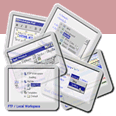Categories
Keywords
Function to list all the network drive mappings
It is very easy to get a list of all the network
drive mappings using the following function. Please note
that you must create
and free the string
list that you pass to it. The return value indicates the
number of network mappings GetNetworkDriveMappings()
was able to find.
function GetNetworkDriveMappings(
sl : TStrings ) : integer;
var
i : integer;
sNetPath : string;
dwMaxNetPathLen : DWord;
begin
sl.Clear;
dwMaxNetPathLen := MAX_PATH;
SetLength( sNetPath,
dwMaxNetPathLen );
for i := 0 to 25 do
begin
if( NO_ERROR =
Windows.WNetGetConnection(
PChar(
'' + Chr( 65 + i ) + ':' ),
PChar( sNetPath ),
dwMaxNetPathLen ) )then
begin
sl.Add( Chr( 65 + i ) + ': ' +
sNetPath );
end;
end;
Result := sl.Count;
end;
//
// here's how to call GetNetworkDriveMappings():
//
var
sl : TStrings;
nMappingsCount,
i : integer;
begin
sl := TStringList.Create;
nMappingsCount :=
GetNetworkDriveMappings( sl );
for i := 0 to nMappingsCount-1 do
begin
//
// do your thing here...
// for now, we'll just display the mapping
//
MessageBox( 0,
PChar( sl.Strings[ i ] ),
'Network drive mappings',
MB_OK );
end;
sl.Free;
end;
|
If you need to programmatically map and delete network drives, look up WNetAddConnection(), WNetAddConnection2(), WNetAddConnection3(), WNetCancelConnection(), and WNetCancelConnection2() in your "Win32 Programmer's Reference."
To share this: BlinkBits | BlinkList | Blogmarks | Co.mments | Connotea | Del.icio.us | Digg | Facebook | FrankIt | Furl | Ma.gnolia | Newsvine | Reddit | Yahoo
Applicable Keywords : Delphi, Delphi 2.x, Functions, Win32
Previous Tip : How to programmatically make your programs run on Windows startup
Random Tip : Quick undo in edit boxes
Next Tip : Create your own hints
Random Tip : Quick undo in edit boxes
Next Tip : Create your own hints

